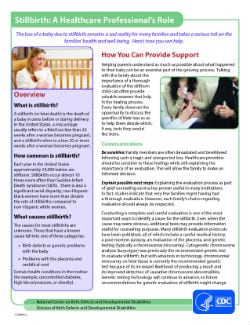What Is Longest a Women Can Live if a Baby Dies Inside Her
The loss of a baby due to stillbirth remains a sad reality for many families and takes a serious toll on families' health and well-being. Learn more about stillbirth below.

A stillbirth is the death or loss of a baby before or during delivery. Both miscarriage and stillbirth describe pregnancy loss, but they differ according to when the loss occurs. In the United States, a miscarriage is usually defined as loss of a baby before the 20th week of pregnancy, and a stillbirth is loss of a baby at or after 20 weeks of pregnancy.
Stillbirth is further classified as either early, late, or term.
- An early stillbirth is a fetal death occurring between 20 and 27 completed weeks of pregnancy.
- A late stillbirth occurs between 28 and 36 completed pregnancy weeks.
- A term stillbirth occurs between 37 or more completed pregnancy weeks..

How Many Babies Are Stillborn?
Stillbirth affects about 1 in 160 births, and each year about 24,000 babies are stillborn in the United States.1 That is about the same number of babies that die during the first year of life and it is more than 10 times as many deaths as the number that occur from Sudden Infant Death Syndrome (SIDS).2
Because of advances in medical technology over the last 30 years, prenatal care (medical care during pregnancy) has improved, which has dramatically reduced the number of late and term stillbirth.3 However, the rate of early stillbirth has remained about the same over time.3
What Increases the Risk of Stillbirth?
Stillbirth with an unknown cause is called "unexplained stillbirth." Having an unexplained stillbirth is more likely to occur the further along a woman is in her pregnancy. Having an autopsy on the baby and other laboratory tests is important in trying to understand why the baby died before birth. Your health care provider can share more information about this.
Stillbirth occurs in families of all races, ethnicities, and income levels, and to women of all ages. However, stillbirth occurs more commonly among certain groups of people including women who:
- are of black race
- are 35 years of age or older
- are of low socioeconomic status
- smoke cigarettes during pregnancy
- have certain medical conditions, such as high blood pressure, diabetes and obesity
- have multiple pregnancies such as triplets or quadruplets
- have had a previous pregnancy loss
This does not mean that every individual of black race or older age is at higher risk for having a stillbirth. It simply means that overall as a group, more stillbirths occur among all mothers of black race or older age when compared to white mothers and mothers under 35 years of age. Differences in factors such as maternal health, income, access to quality health care, stress, social and emotional support resources and cultural factors may explain how these factors are related to having a stillbirth. More research is needed to determine the underlying cause of stillbirths in these populations.
These factors are also associated with other poor pregnancy outcomes, such as preterm birth.
What can be done?
CDC works to learn more about who might have a stillbirth and why. CDC does this by tracking how often stillbirth occurs and researching what causes stillbirth and how to prevent it. Knowledge about the potential causes of stillbirth can be used to develop recommendations, policies, and services to help prevent stillbirth. While we continue to learn more about stillbirth, much work remains. To learn more about CDC's activities, visit the Stillbirth CDC Activities page.
References
- Hoyert DL, Gregory ECW. Cause of fetal death: Data from the fetal death report, 2014. National vital statistics reports; vol 65 no 7. Hyattsville, MD: National Center for Health Statistics. 2016.[Read the report pdf icon [602 KB / 25 pages]]
- Xu JQ, Kochanek KD, Murphy SL, Arias E. Mortality in the United States, 2012. NCHS data brief, no 168. Hyattsville, MD: National Center for Health Statistics. 2014. [Read report pdf icon [553 KB / 8 pages]]
- MacDorman MF, Kirmeyer SE, Wilson EC. Fetal and perinatal mortality, United States, 2006. National vital statistics reports; vol 60 no 8. Hyattsville, MD: National Center for Health Statistics. 2012. [Read data brief pdf icon [432 KB / 23 pages]]
What Is Longest a Women Can Live if a Baby Dies Inside Her
Source: https://www.cdc.gov/ncbddd/stillbirth/facts.html
0 Response to "What Is Longest a Women Can Live if a Baby Dies Inside Her"
Post a Comment